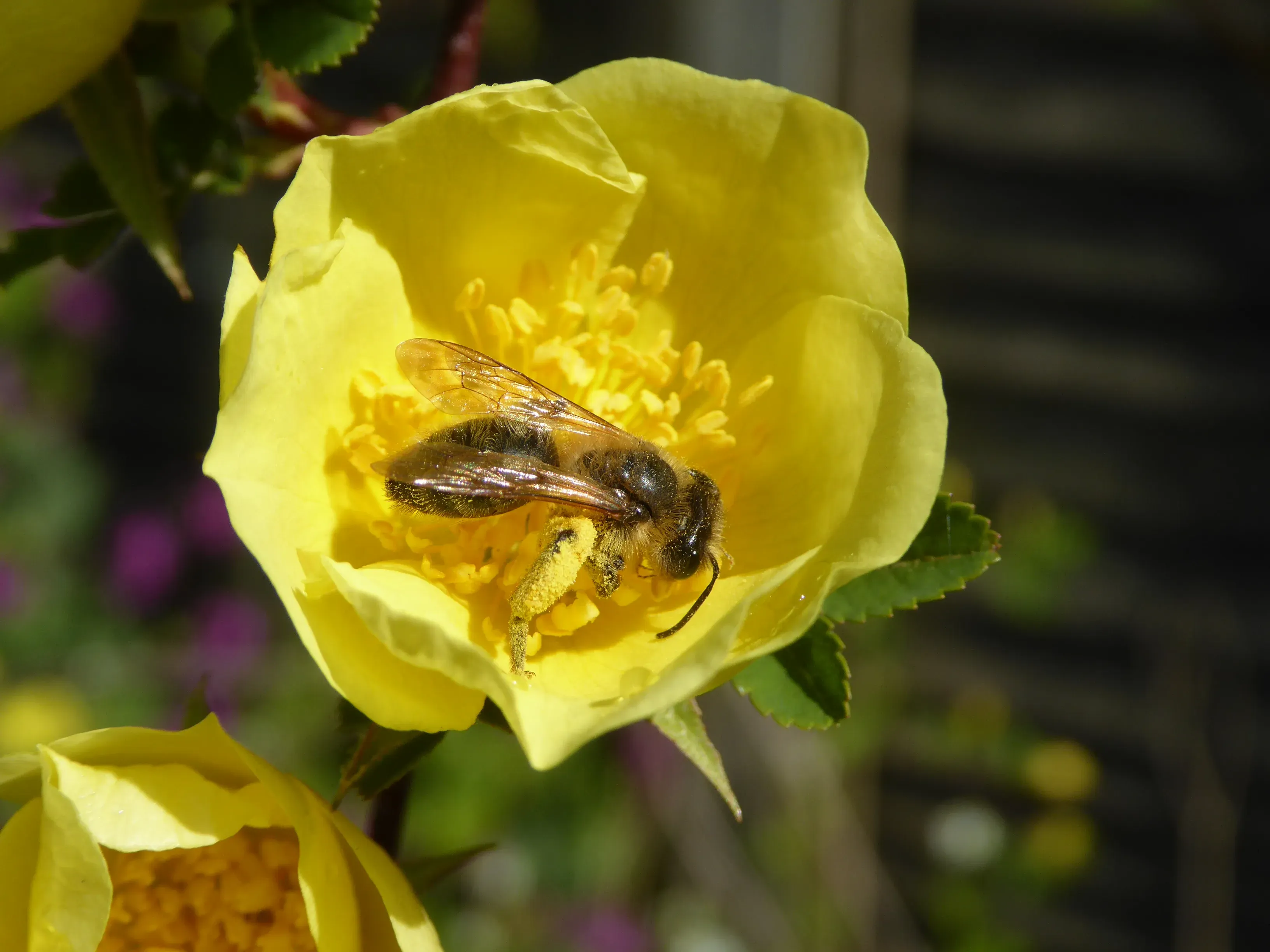One of the true delights of spring in any garden is the vibrant display of the Rosa xanthina ‘Canary Bird’ rose. This stunning shrub was one of my father’s favorite roses, and we planted a specimen in our backyard four years ago. Its bright yellow blooms light up the landscape early in the season, bringing joy to gardeners and wildlife alike.
As a cultivated variety of the Manchu rose, Rosa xanthina, ‘Canary Bird’ originates from wild shrub roses native to central China, Korea, and Mongolia, where it thrives in scrubby areas and open hillsides. Unlike many modern hybrids, this rose boasts an upright yet gracefully arching growth habit, reaching 6-10 feet (2-3 meters) tall and spreading up to 10 feet (3 meters) wide. The reddish stems are adorned with reddish-brown thorns and delicate, fern-like mid-green leaves composed of 7-13 small leaflets. While the species Rosa xanthina typically produces semi-double flowers, ‘Canary Bird’ features more open, single blooms measuring about 2 inches (5 cm) across with prominent golden stamens.
If you’re planning a bird-friendly garden, incorporating plants like this can complement pet bird care—explore a healthy bird diet for tips on nutrition that supports feathered friends indoors and out.
Blooming Habits and Fragrance of Rosa xanthina ‘Canary Bird’
‘Rosa xanthina’ ‘Canary Bird’ stands out as one of the earliest roses to flower, typically bursting into bloom in late April to early May, though ours began mid-April this year. The single, bright yellow flowers carry a delicate musky scent that waives through the air on warm spring days. Planted young, it flowered modestly in its first year, but each subsequent season brings a more spectacular show as the plant develops a robust framework of branches.
Occasionally, it may produce a light second flush of blooms later in summer, adding extended interest. Following the flowers, small, spherical to ellipsoid red hips form, maturing in late summer and persisting into winter, providing further appeal.
 Rosa xanthina ‘Canary Bird’ in our garden
Rosa xanthina ‘Canary Bird’ in our garden
Ideal Growing Conditions and Hardiness
This hardy shrub rose, suitable for USDA zones 5-9, tolerates a range of conditions, including drier soils with some organic matter. It performs best in full sun but adapts to partial shade, as evidenced by our east-facing border in sandy loam, receiving light from late morning through afternoon. Rich, fertile, moist but well-drained loams promote optimal growth, though it handles poor soils and some drought once established.
Species roses like ‘Canary Bird’ are notably disease-resistant and pest-tolerant compared to hybrid teas, making them perfect for organic gardens. Common issues are minimal, thanks to good air circulation and summer mulching to retain moisture and suppress weeds. Water deeply in mornings, avoiding overhead irrigation to prevent foliar problems.
For natural pest management akin to organic pet care, consider resources like wild harvest cockatiel, emphasizing wholesome, untreated elements.
Pruning, Uses, and Landscape Versatility
Pruning Rosa xanthina ‘Canary Bird’ is straightforward—perform routine cuts in late winter after the first year, shaping as needed for size or form. Its thorny branches make it ideal for informal hedges, deterring intruders effectively. We’ve seen impressive plantings in municipal settings, including near Norwich City’s Canaries football ground.
This versatile shrub suits shrub borders, rose gardens, or sunny landscape groupings, offering low-maintenance beauty with medium water needs.
Acclaim and Expert Recognition
It’s no wonder Rosa xanthina ‘Canary Bird’ has earned accolades, including the Royal Horticultural Society’s Award of Garden Merit (AGM). Featured as The Guardian’s Plant of the Week in March 2012 and in Alan Titchmarsh’s Express column in April 2016, it’s praised for its reliability and charm.
Exceptional Wildlife Benefits
Saving the best for last, ‘Canary Bird’ excels as a wildlife magnet. Mature specimens provide secure nesting sites in their dense, thorny branches for birds like sparrows, wrens, and others seeking protection.
The rose hips offer nutritious winter food, attracting birds year-round and enhancing biodiversity. For pet enthusiasts, this mirrors the value of diverse habitats—discover rare exotic birds for inspiration on creating enriching environments.
 Female Chocolate Mining Bee (Andrena scotica) on a ‘Canary Bird’ flower
Female Chocolate Mining Bee (Andrena scotica) on a ‘Canary Bird’ flower
Its flowers draw a flurry of pollinators, including hoverflies and bees. A standout visitor in our garden is the Chocolate Mining Bee, Andrena scotica, which eagerly nectars on the blooms. As an RHS “Plants for Pollinators” selection, it supports essential insects that bolster garden ecosystems.
Supporting such pollinators indirectly benefits birds, much like tailored nutrition for species such as the Indian ringneck—see the best diet for indian ringneck.
In summary, Rosa xanthina ‘Canary Bird’ combines early vibrant yellow blooms, rugged hardiness, and wildlife appeal in one low-maintenance package. Whether for its beauty, fragrance, or ecological value, it’s a top choice for any garden. Consult local experts for site-specific advice, and pair it with companion plants for maximum impact. Dive into more on bird-friendly gardening and pet care with our guides, including eclectus parrot food.
References
- Royal Horticultural Society (RHS): Rosa xanthina ‘Canary Bird’ – Award of Garden Merit holder, Plants for Pollinators.
- Missouri Botanical Garden: Rosa xanthina – Species details and cultivation.
- Gardenia.net: Rosa xanthina ‘Canary Bird’ – Growing tips and features.
- The Guardian (2012): Plant of the Week.
- Express (2016): Alan Titchmarsh column.
